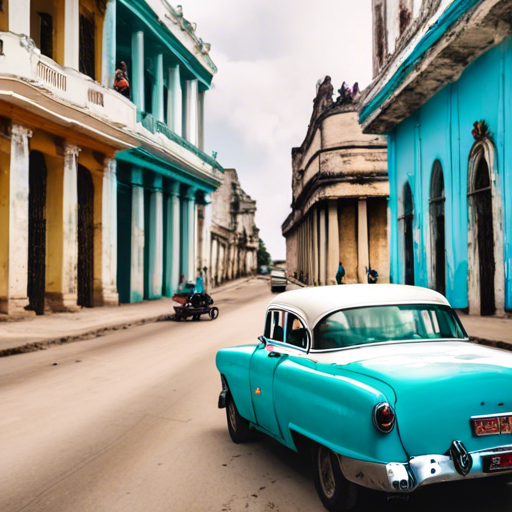top historical landmarks to explore in cuba

Top Historical Landmarks to Explore in Cuba
Welcome to our comprehensive guide on the top historical landmarks to explore in Cuba. This Caribbean island is not only renowned for its stunning beaches and vibrant culture but also for its rich history. From colonial architecture to revolutionary sites, Cuba offers a plethora of landmarks that provide a window into its past. In this article, we will delve into the most significant historical sites that every traveler should visit.
Havana's Old Town (Habana Vieja)
Havana's Old Town, known as Habana Vieja, is a UNESCO World Heritage site and a must-visit for history enthusiasts. This area is a living museum of Spanish colonial architecture, with buildings dating back to the 16th century.
Plaza de la Catedral
The Plaza de la Catedral is one of the most iconic squares in Habana Vieja. It is home to the stunning Cathedral of Havana, a masterpiece of Baroque architecture. The square is surrounded by beautifully restored colonial buildings, making it a perfect spot for photography and leisurely strolls.
Key Highlights:
- Cathedral of Havana: A prime example of Cuban Baroque architecture.
- Palacio de los Marqueses de Aguas Claras: A historic mansion turned restaurant.
- El Patio: A famous restaurant offering traditional Cuban cuisine.
Plaza Vieja
Plaza Vieja is another significant square in Habana Vieja. Originally laid out in 1559, it has served various purposes over the centuries, from a market to a site for executions. Today, it is a vibrant area filled with cafes, galleries, and shops.
Key Highlights:
- Camara Oscura: Offers panoramic views of the city.
- Planetarium: A great place for astronomy enthusiasts.
- Microbrewery: Enjoy locally brewed beers.
Castillo del Morro
The Castillo del Morro, officially known as Castillo de los Tres Reyes del Morro, is a fortress guarding the entrance to Havana Bay. Built in the late 16th century, it played a crucial role in protecting the city from pirates and invaders.
Historical Significance
This fortress is not only an architectural marvel but also a symbol of Cuba's colonial past. It offers breathtaking views of the bay and the city, making it a popular spot for tourists.
Key Highlights:
- El Cañonazo Ceremony: A nightly cannon firing ceremony.
- Maritime Museum: Exhibits on naval history and piracy.
- Scenic Views: Panoramic views of Havana and the sea.
Revolution Square (Plaza de la Revolución)
Revolution Square is one of the most significant political and historical sites in Cuba. It has been the venue for many important events, including speeches by Fidel Castro and other revolutionary leaders.
Monuments and Memorials
The square is dominated by the José Martí Memorial, a towering structure dedicated to the national hero. The surrounding buildings feature iconic murals of Che Guevara and Camilo Cienfuegos, making it a powerful symbol of Cuba's revolutionary spirit.
Key Highlights:
- José Martí Memorial: A 109-meter tall tower with a museum and observation deck.
- Ministry of the Interior: Features the famous Che Guevara mural.
- Ministry of Communications: Adorned with a mural of Camilo Cienfuegos.
Trinidad
The town of Trinidad is another UNESCO World Heritage site that offers a glimpse into Cuba's colonial past. Founded in the early 16th century, it is one of the best-preserved colonial towns in the Americas.
Plaza Mayor
The Plaza Mayor is the heart of Trinidad, surrounded by beautifully restored colonial buildings and cobblestone streets. It is a perfect place to start your exploration of this charming town.
Key Highlights:
- Museo Romántico: Showcases 19th-century furnishings and decor.
- Church of the Holy Trinity: A historic church with stunning architecture.
- Casa de la Música: A popular spot for live music and dancing.
Valle de los Ingenios
The Valle de los Ingenios, or Valley of the Sugar Mills, is located just outside Trinidad. This area was once the center of Cuba's sugar industry and is dotted with the ruins of sugar mills and plantation houses.
Key Highlights:
- Manaca Iznaga Tower: Offers panoramic views of the valley.
- Ingenio San Isidro de los Destiladeros: A well-preserved sugar mill.
- Plantation Houses: Explore the remnants of colonial-era plantations.
Bay of Pigs (Bahía de Cochinos)
The Bay of Pigs is a site of immense historical significance due to the failed invasion attempt by CIA-backed Cuban exiles in 1961. This event played a crucial role in shaping Cuba's modern history.
Playa Girón Museum
The Playa Girón Museum is dedicated to the Bay of Pigs invasion. It offers a detailed account of the events leading up to the invasion, the battle itself, and its aftermath.
Key Highlights:
- Exhibits: Artifacts, photographs, and documents from the invasion.
- Military Equipment: Displays of tanks, aircraft, and other military hardware.
- Memorials: Monuments honoring the Cuban defenders.
Natural Beauty
In addition to its historical significance, the Bay of Pigs is known for its natural beauty. The area is home to pristine beaches, crystal-clear waters, and abundant marine life, making it a popular destination for snorkeling and diving.
Key Highlights:
- Playa Larga: A beautiful beach ideal for relaxation.
- Cueva de los Peces: A natural swimming hole teeming with fish.
- Snorkeling and Diving: Explore the vibrant coral reefs and underwater caves.
Conclusion
Cuba is a treasure trove of historical landmarks that offer a fascinating glimpse into its past. From the colonial charm of Havana's Old Town to the revolutionary spirit of Revolution Square, each site tells a unique story. Whether you are a history buff or simply looking to explore the rich cultural heritage of this Caribbean island, these landmarks are sure to leave a lasting impression.
For more travel tips and guides, visit this link and this link.
FAQ
| Question | Answer |
|---|---|
| What is the best time to visit Cuba? | The best time to visit Cuba is from November to April when the weather is dry and pleasant. |
| Do I need a visa to visit Cuba? | Yes, most travelers need a visa to enter Cuba. It is advisable to check the specific requirements for your country. |
| Is it safe to travel to Cuba? | Yes, Cuba is generally considered safe for tourists. However, it is always wise to take standard precautions. |
| What currency is used in Cuba? | Cuba uses the Cuban Peso (CUP) and the Cuban Convertible Peso (CUC). It is important to familiarize yourself with the currency system before traveling. |
| Can I use credit cards in Cuba? | Credit cards are accepted in some places, but it is advisable to carry cash, especially in rural areas. |
